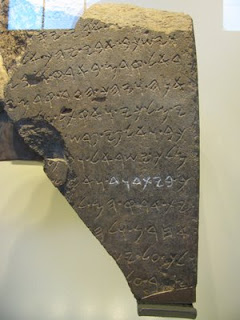Our guide had us up with the chickens today because we had a packed itinerary. A quick breakfast and off we went to our “appointed time” to view the Western Wall (Wailing Wall) Tunnels. Guides have to schedule their groups because of the extremely numerous tourists. Our itinerary included so much—Wailing Wall, Western Wall Tunnels, Wohl Museum, Burnt House Museum, Israel Museum and Shrine of the Book, tombs of Ketef Hinnom, and Bethlehem--that I have time and room for only some highlights.
Most people don’t realize that part of the Wailing Wall (men’s section) is under a tunnel, and inside the tunnel (dug for archeological excavations) is a women’s section that overlooks the men’s portion. Further on is another section where the women come to pray. These areas are closer to the location of the “Holy of Holies” of the former Temple. Therefore the people want to pray as close as possible to this sacred place. Our guide gave us so much information about the tunnels and the walls that our heads are swimming with information overload.
A word of caution for any visiting Jerusalem on their own or with another tour group: if you have claustrophobia, do NOT go through the tunnels. A lengthy portion is so narrow that it’s necessary to walk single file.
 |
| Me in front of the Wailing Wall after our walk through the tunnels. |
 |
| Silver Amulet |
 |
| House of David Inscription - hig |
Following our museum visit, we went to Ketef Hinnom, an area just below our hotel not visible from the hotel because of the topography. Here are several tombs and where the silver amulets had been found. Several years ago during an archaeological dig in another tomb here magnificent riches were discovered. The tomb dates from the same time period as Lehi of The Book of Mormon.
 |
| Tomb of Riches - square opening |
 |
| Tombs below our hotel |
From there we drove a short way to Bethlehem. Our guide Yossi, an Israeli citizen, cannot go into Bethlehem, but our Arab driver can. It was this way the last time we were here—an Arab driver and Israeli guide. This arrangement allows a tour group to easily make the transition between the two different areas. After going through the check points, we arrived a little after three o’clock. The Armenians have a service in the church of the Nativity every day at that time so we were unable to visit the church. In the meantime—shopping! Bethlehem is a good place to buy olive wood carvings. The retired music teacher in our group purchased a shofar horn made of ram’s horn. She had the salesmen blow on different horns so she could choose the one with the sound she liked best!
Our Arab guide was at the shop waiting for us. Her name is Gabriela, a former Romanian. An attractive, extremely personable person, she is an excellent guide! We were fortunate not only to have such a good guide but to be at the Church of the Nativity when few tourists where there. What a difference that made! Before we got to the church, however, she shared with us about the “fields” of Bethlehem shown in the photo below. Now there are homes there.
 |
| Former Shepherds Fields below Bethlehem |
This area is significant for several reasons. In the Book of Ruth, we meet Naomi and her family, including one of her daughters-in-law, Ruth. In the distance of the photo (a little hazy today) are the hills of Moab, Ruth’s home. When Naomi’s sons died, she returned home to Bethlehem, the area shown in the photo. As most of us know, Ruth came with her. She followed her mother-in-law’s advice and ended up as the bride of Boaz, of the House of David. She was the great-grandmother of Jesus. These same fields are where the shepherds were “keeping watch over their flocks by night” and the angels appeared to them.
Throughout Israel, huge churches have been built over most of the important places associated with the life of Jesus. The “stable” referred to in the Scriptures where Jesus was born most likely was a large cave where not only animals were kept but people dwelt. Under the Church of the Nativity is such a cave. The exact location of Jesus’ birth place within the cave is unknown but a spot has been designated in order to commemorate the event. The photo here shows the manger—not made of wood but of stone.
So much to tell that it would fill a book! These are the highlights today. Exhausted but thrilled with our discoveries, we came back to the hotel to find a local film crew filming a movie. If I find out more about the film, I’ll post it later.
Tomorrow appears to be just as busy as today, so I need to get to bed. Until then……
